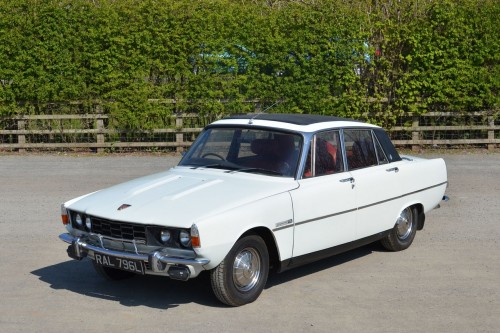
Click Here for Full Screen Image - Click Here to Download Image
 |  |  |  |  | |||||
 |  |  |  |  | |||||
 |  |  |  |  | |||||
 |  |  |  |
| Lot number | 5 |
|---|---|
| Hammer value | £2,200 |
| Description | Rover P6 2000TC |
| Registration | RAL 796L |
| Year | 1972 |
| Colour | Davos White |
| Engine size | 1,978 cc |
| Chassis No. | 44617629C |
| Engine No. | 44609723A |
A real landmark in car design, the Rover P6 set new standards for performance and refinement when it first appeared in 1963 and was immediately voted ‘Car of the Year’.
A luxury 4-door family saloon with a well-appointed interior, the P6 featured an all steel monocoque central cell onto which all the outer body panels were bolted including an aluminium bonnet and boot lid. Suspension was independent all round and employed a de Dion tube arrangement at the rear which enabled the car to remain level at high cornering speeds. Servo-assisted four-wheel disc brakes were also fitted, with the rear discs being mounted inboard.
It was so advanced from the outset that it never needed much in the way of facelifts throughout its 13-year production run. Initially only available with a 104bhp 2-litre engine, a more sporting 124bhp twin-carb 2000TC was available from 1966 which could sprint to 60mph in 11 seconds on its way to a top speed of 110mph with improved Girling disc brakes to bring it safely to a halt. The P6 range continued to sell in healthy numbers until the arrival of the ‘flying wedge’ SD1 cars in 1976.
As the original purchase invoice confirms, this particular 2000TC was bought new by a Mr Walter Fox of Sutton-in-Ashfield, Notts, from Rover dealers James Windsor & Son of Mansfield in November 1972 for the sum of £2,090 (and 94 shillings!) including a heated rear window, insurance and number plates. Davos White with a red leather interior and a 4-speed manual gearbox, it has had six further keepers since then, the current owner (recently deceased) acquiring it in January 2010 with around 89,000 miles on the clock.
Always well maintained, it comes with a substantial history file including the original Passport to Service book which is stamped 16 times up to 48,426 miles in July 1977, with handwritten notes at the back of the book documenting another 10 services up to 99,922 miles in 1998 with various supporting invoices. One of the bills shows that the engine was rebuilt in June 1979 (including four new pistons) at around 56,000 miles, while a stainless steel exhaust with a ‘vehicle life guarantee’ was fitted in 1995.
Other bills show yet more servicing up to 2006 when it appears that the car was laid up for a few years, MOTs and maintenance invoices resuming in August 2010 and continuing up until the summer of 2014. There are also some 16 old MOTs from 1996 (at 99,143 miles) to 2014 (at 109,293 miles), the current MOT expiring 20th July 2015.
It also comes with all its original handbooks, still in the original Rover wallet, a large factory workshop manual, two bound volumes of period ‘Rover Service News Letters’ plus the aforementioned service history and original bill of sale.
Said to be in good running order and reputedly the “pride and joy” of its recently deceased owner, this much-cherished and well-historied Rover now needs a caring new guardian to attend to some minor bodywork issues that are beginning to emerge – and to enjoy the ambience of that beautifully preserved red leather interior with its full-length fabric sunroof.
Autocar recently ran a feature where they invited the judging panel for this year’s ‘Car of The Year’ awards to drive a 1964 Rover 2000 (winner of the 1964 ‘Car of The Year’ award) to see how it compared.The judges universally praised the Rover for its outstanding blend of handling and ride comfort (superior to the bulk of the 2015 contenders), the ambience and airiness of its cabin (far more characterful than the bland, claustrophobic moderns) and the sheer pleasure to be had from savouring the way the car reacted to every input from the controls (a level of driver involvement sadly lacking in today’s competent but anaesthetised appliances).
Solihull Rovers – 2
Modern World – 0
Result.